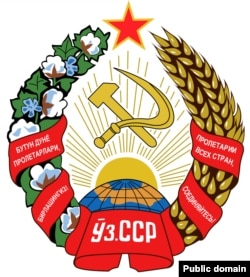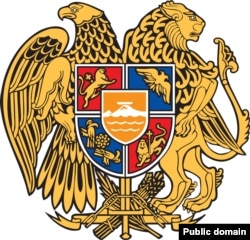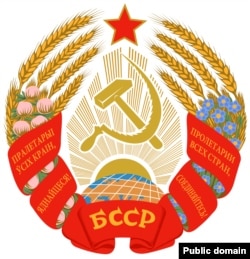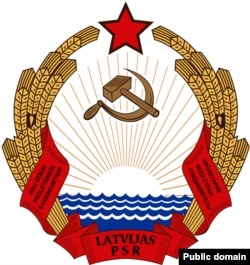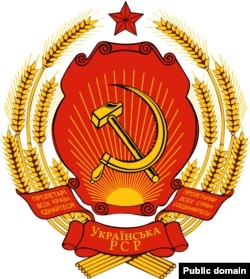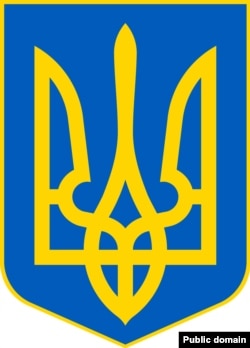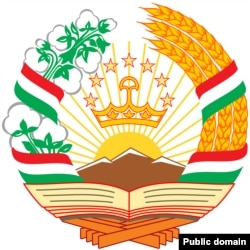After Belarus (slightly) updated its official crest, we had a look at some other former Soviet emblems, before and after independence.
Uzbek S.S.R.
All Soviet emblems were required to feature the hammer and sickle, sheaves of wheat, a rising sun, and the red star of communism. The Marxist phrase “Workers of the world, unite!” was also mandatory. The Uzbek crest sported a flowering sprig of cotton and the words "Uz. SSR," an abbreviation of "Uzbek Soviet Socialist Republic."
Uzbekistan
Independent Uzbekistan's emblem features the mythical Simurgh bird in front of a lush Uzbek landscape cut through by Central Asia's Syr Darya and Amu Darya rivers. The winged Simurgh is a popular character of Persian folklore that is also depicted on Iranian currency. At the top of the emblem is the crescent of Islam.
Armenian S.S.R.
The Soviet-era Armenian emblem featured the twin peaks of Mount Ararat, which has lain inside the border of Turkey since 1921 but can be seen rising majestically above Armenia’s capital, Yerevan, on clear days. The plump bunch of grapes is a nod to the country’s viticultural heritage, which dates back some 6,000 years.
Armenia
The current emblem stars a watchful eagle and lion, which are symbols of Armenia’s pre-Christian empire. On the shield are the coats of arms of four ancient Armenian dynasties. In the center of the shield, Noah's Ark is depicted teetering on the summit of Mount Ararat. According to the Old Testament, the ark came to rest atop Ararat after the great flood subsided.
Byelorussian S.S.R.
The blue flowers of the flax plant (right) and pink clovers decorate the Soviet-era emblem. Belarus has a long tradition of linen production that is made from flax fibers.
Belarus
In the (recently subtly modified) emblem, the communist hammer and sickle has been replaced with a map of Belarus, but the communist star remains. Belarus is the only fully recognized former Soviet country to retain the red star in its national emblem. It is believed red stars became associated with communist dictatorship as a result of a 1908 science fiction novel called Krasnaya Zvezda (Red Star), about a socialist utopia on Mars.
Latvian S.S.R.
The strip of Baltic sea featured on the Latvian emblem created a symbolic dilemma when coupled with the socialist "sunrise" required in all Soviet emblems. Latvia's coastline faces west, meaning only sunsets are visible over the Baltic Sea. The design blunder inevitably led to jokes about the decline of socialism in Europe. The Latvian words at the bottom of the emblem mean "Latvian S.S.R."
Latvia
Independent Latvia’s three historical regions are represented by stars at the top of the country's coat of arms. A lion and griffin symbolize other areas of the country, while the rising sun (with no Baltic Sea in sight) represents freedom. Oak leaves, which are a symbol of the country, decorate the bottom of the coat of arms.
Ukrainian S.S.R.
The emblem is dominated by sheaves of wheat, in reference to Ukraine's agricultural reputation as the "breadbasket" of the Soviet Union.
Ukraine
The coat of arms is based on a trident, which was a symbol of Volodymyr the Great, the ruler of Kievan Rus.
In late 2020, a contest was held to create a more elaborate Ukrainian emblem with the trident as its centerpiece. The winning design proved to be an unpopular choice. One critic noted, "The time when [approving a greater national emblem] could be done painlessly is over." An updated emblem will be voted on by Ukraine’s parliament in 2021 but is widely expected to be rejected by lawmakers.
Tajik S.S.R.
The Soviet emblem featured here was used in the 1930s before being replaced by a more generic version. As well as focusing on Tajikistan’s landscape, hydropower stations, and agriculture, the emblem features a cluster of silkworm cocoons (beneath the hammer and sickle) in reference to the once-famous luxury fabric production of Tajikistan's Silk Road cities.
Tajikistan
The current emblem features sprigs of cotton and wheat, and the country's famous mountains. Sources differ on the meaning of the crown, but according to one interpretation it pays subtle homage to Tajiks' pre-Islamic fire-worshipping heritage by including three small flames. An unspecified book lies open at the base of the emblem.

